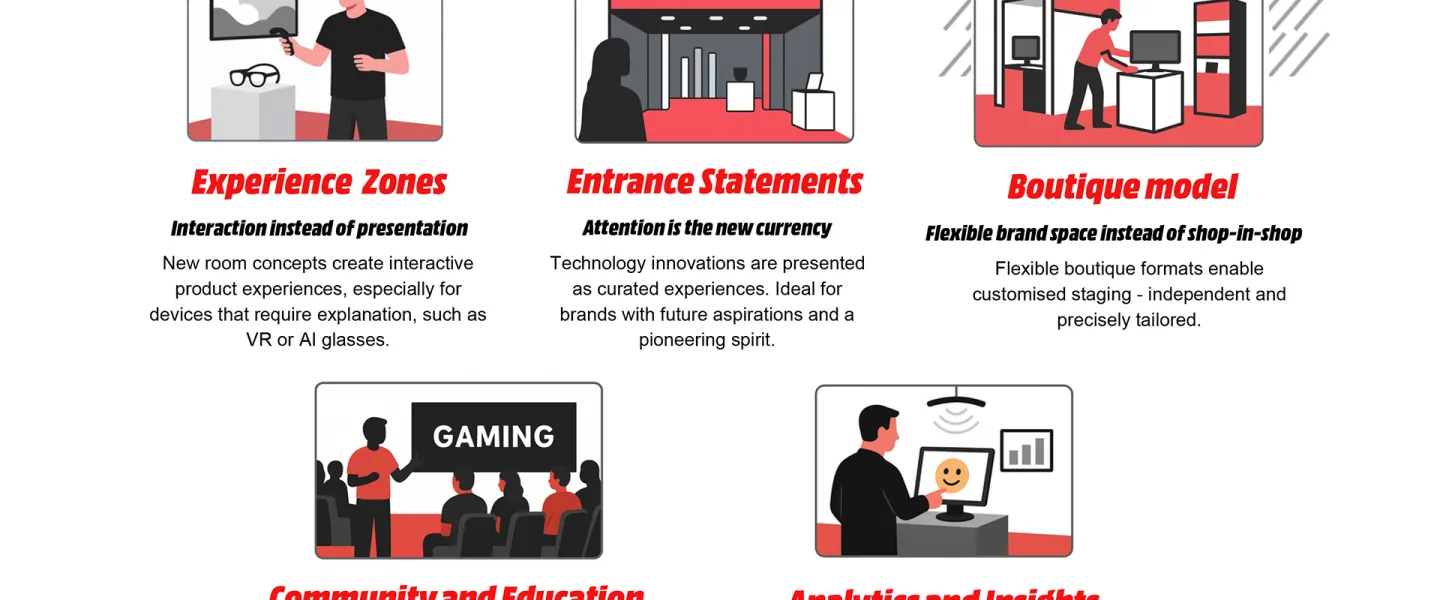
How physical space concepts are redefining the tech experience
MediaMarktSaturn is responding to the growing need of customers to experience complex technologies not only digitally, but also physically and with all their senses. Instead of traditional sales areas, innovative experience spaces are being created that combine interaction, brand staging, and education into a holistic experience, making technological innovation tangible, relevant, and trustworthy.
The more complex digital technologies become, the greater the need for real, sensory product experiences. Especially innovations in the fields of virtual reality, AI, or smart wearables can hardly be fully grasped online—they need to be tried out, experienced, and understood.
This principle is increasingly shaping brick-and-mortar retail as well. Instead of classic sales areas, flexible experience zones are emerging, where technology can be explored in a contextual and everyday manner. MediaMarktSaturn is now implementing this concept together with technology partner Meta—as part of the Space-as-a-Service strategy, which transforms retail space into brand-adaptable experience environments. For decision-makers in retail, marketers, and brand experience managers, Marcus Tengler, responsible for Real Estate & Store Concepts at MediaMarktSaturn, outlines the five central pillars that make physical space concepts a success factor for technological innovation:
- Experience Zones: Technology Testing Instead of Product Presentation
Successful space concepts enable authentic, interactive product experiences. Especially for products that require explanation, such as VR headsets or AI-powered glasses, the classic shelving principle is outdated. Customers want to immerse themselves in scenarios where they can experience the device as they would use it in everyday life.
In the so-called Experience Zones at MediaMarktSaturn, the physical space becomes a digital resonance chamber. Technology is no longer just explained, but contextualized and made tangible—in immersive settings that create curiosity and trust.
- Entrance Statements: Attention Is the New Currency
First impressions count. Modern tech space concepts therefore rely on striking entrance stagings to immediately engage visitors visually and thematically. These “entrance statements” provide orientation, convey a promise of innovation, and increase dwell time.
Technological product innovations thus receive a stage that does not feel like advertising, but rather like a curated introduction to the experience space. This moment of surprise is especially valuable for brands that stand for pioneering spirit and future technology.
- Boutique Model: Flexible Brand Space Instead of Shop-in-Shop
Instead of classic shop-in-shop systems, progressive retailers are increasingly turning to modular brand areas that can be individually designed—similar to a professional trade fair booth. These boutique formats, as featured in MediaMarktSaturn’s largest shop format “Lighthouse,” offer manufacturers the opportunity to present their technologies independently and in a thematically appropriate way.
The result: temporary brand worlds that can be dynamically adapted to campaigns, target groups, and product cycles. The physical environment thus becomes a creative tool for differentiated brand communication.
- Community & Education: From Point of Sale to Learning Environment
Technology often requires not just explanation, but also guidance and exchange. Events, workshops, or guided demonstrations expand the experience space to include social and educational components, making the store a community platform.
Especially in the gaming, VR, or AI sectors, it becomes clear: shared experiences not only strengthen customer loyalty, but also product understanding. Where exchange is possible, trust and sustainable access to innovation are created. MediaMarktSaturn is already pursuing this community approach in its gaming experience worlds “Xperion,” where events for the gamer community take place on large areas and live stages.
- Analytics & Insights: When Experiences Become Measurable
Physical experiences leave traces, and these can provide valuable insights. With the help of sensors, movement analyses, or feedback terminals, customer interactions can be evaluated in real time. This generates data-based insights that support product development, space planning, and communication strategies.
The experience space thus becomes an intelligent feedback loop. Companies gain a better understanding of which features are convincing, where explanations are needed, and which type of staging actually leads to action.
Conclusion: Spaces That Enable Thinking, Feeling, and Action
Brick-and-mortar retail is evolving—not despite, but because of digitalization. Those who rethink it, not as a rigid space but as a service infrastructure for experience, open doors to a deeper relationship between people and technology.
Physical space concepts that are adaptive, immersive, and community-oriented offer real added value—for customers, brands, and retailers alike. Especially when it comes to future technologies, this is where curiosity turns into relevance and relevance into purchase interest.



